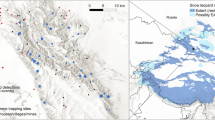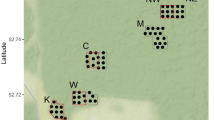Abstract
We introduced a technique based on ground-based track counts in snow for simultaneously estimating the abundance and distribution of Japanese macaques Macaca fuscata (Blyth, 1875) and evaluated its efficiency by conducting a field trial in northern Japan. Within the 50-km2 area, we selected five transects with consideration of the spatial distribution of vegetation, local climate, and geographical conditions contained in the entire area. Five trained researchers recorded the track counts three times in those geolocations that intersected with each transect. We estimated the macaque abundance by the line-intercept sampling (LIS) technique using the number of tracks and predicted its distribution by ecological-niche factor analysis (ENFA) using the tracks as a proof of macaques’ presence. We confirmed that the LIS-based technique could yield reasonably accurate estimates of the number of individuals and troops, compared with the population estimates of macaques based on the home-range method. We successfully used ENFA in constructing a macaque distribution model that had a high predictive performance; this was verified by comparing the predicted macaque distribution with the actual use of habitat obtained by tracking radio-tagged troops in the study area.


Similar content being viewed by others
References
American Society of Mammalogists (1998) Guidelines for the capture, handling, and care of mammals as approved by the American Society of Mammalogists. J Mammal 74:1416–1431
Becker EF (1991) A terrestrial furbearer estimator based on probability sampling. J Wildl Manage 55:730–737
Boyce MS, Vernier PR, Nielsen SE, Schmiegelow FKA (2002) Evaluating resource selection functions. Ecol Modell 157:281–300
Brugiere D, Fleury MC (2000) Estimating primate densities using home range and line transect methods: a comparative test with the Black Colobus Monkey Colobus satanas. Primates 41:373–382
Caughley G, Gunn A (1996) Conservation biology in theory and practice. Blackwell, Oxford, pp 1–459
Efron B, Tibshirani R (1986) Bootstrap methods for standard errors, confidence intervals, and other measures of statistical accuracy. Stat Sci 1:54–77
Enari H, Maruyama N (2005) Monkeys patrols and rural tourism in Nishimeya village, Aomori prefecture, Japan. Biosphere Conservation 7:11–28
Enari H, Suzuki T (2010) Risk of agricultural and property damage associated with the recovery of Japanese monkey populations. Landsc Urban Plan 97:83–91
Enari H, Maruyama N, Sakamaki H (2006) Socio-ecological effects of monkey patrol on Japanese macaques in Nishimeya Village, Aomori Prefecture, Japan. Biosph Conserv 7:57–81
Fattorini L, Marcheselli M (2002) Empirical investigation about statistical properties of abundance estimates based on line-intercept and network sampling of tracks. Statistical Methods and Applications 11:217–226
Fielding AH, Bell JF (1997) A review of methods for the assessment of prediction errors in conservation presence/absence models. Environ Conserv 24:38–49
Guisan A, Zimmermann ZE (2000) Predictive habitat distribution models in ecology. Ecol Modell 135:147–186
Hanya G, Yoshihiro S, Zamma K, Kubo R, Takahata Y (2003) New method to census primate groups: estimating group density of Japanese macaques by point census. Am J Primatol 60:43–56
Hanya G, Yoshihiro S, Zamma K, Matubara H, Ohtake M, Kubo R, Noma N, Agetusma N, Takahata Y (2004) Environmental determinants of the altitudinal variations in relative group densities of Japanese macaques on Yakushima. Ecol Res 19:485–493
Hayashi C (1997) Estimating the abundance of wild mammals. In: Japanese Wildlife Research Society (ed) Field research techniques for forest mammals. Kyoritsu, Tokyo. pp 7–29. (In Japanese)
Hayashi C, Komazawa T, Hayashi F (1979) A new statistical method to estimate the size of animal population—estimation of population size of hare. Ann Inst Stat Math 31:325–348
Hirzel AH, Arlettaz R (2003) Environmental-envelope based habitat-suitability models. In: Manly BFJ (ed) Proceedings of the first international conference on resource selection by animals. Omnipress, Wyoming, pp 67–76
Hirzel AH, Guisan A (2002) Which is the optimal sampling strategy for habitat suitability modelling. Ecol Modell 157:331–341
Hirzel AH, Hausser J, Chessel D, Perrin N (2002) Ecological-niche factor analysis: how to compute habitat-suitability maps without absence data? Ecology 83:2027–2036
Horvitz DG, Thompson DJ (1952) A generalization of sampling without replacement from a finite universe. J Am Stat Assoc 57:663–685
Imaki H, Koganezawa M, Okumura T, Maruyama N (2000) Home range and seasonal migration of Japanese macaques in Nikko and Imaichi, central Honshu, Japan. Biosph Conserv 3:1–16
Iwamoto T (1978) Food availability as a limiting factor on population density of the Japanese macaque and Gelada baboon. In: Chivers DJ, Herbert J (eds) Recent advances in primatology—volume one behavior. Academic, London, pp 287–303
Iwano T (1980) Distribution of Japanese macaques and its environment factors. In: Japan Wildlife Research Center (ed) The second national survey on the natural environment report. Environmental Agency, Tokyo. pp 22–35. (In Japanese with English summary)
Izumiyama S (1999) Effect of meteorolic condition in snowy term and seasonal traveling distance of Japanese macaque, in Kamikochi. Primate Research 15:343–352, In Japanese with English summary
Izumiyama S, Mochizuki T, Shiraishi T (2003) Troop size, home range area and seasonal range use of the Japanese macaque in the Northern Japan Alps. Ecol Res 18:465–474
Koganezawa M (1991) The effect of severe winter on natality of Japanese macaques in Nikko. In: Ehara A (ed) Primatology today. Elsevier, Amsterdam, pp 129–130
Koganezawa M, Imaki H (1998) The effects of food sources on Japanese macaque home range size and location, and population dynamics. Primates 40:177–185
Lancia RA, Nichols JD, Pollock KH (1994) Estimating the number of animals in wildlife populations. In: Bookhout T (ed) Research and management techniques for wildlife and habitats. The Wildlife Society, Maryland, pp 215–253
Mitani M, Ikeguchi H (1997) The Japanese macaques in a potential natural vegetation: case studies in the Hyogo prefectural area, Japan. Reichorui Kenkyu 13:1–18, In Japanese with English summary
Mito Y (1992) Why is the present distribution of Japanese macaques so small in the Tohoku district? Biological Science 44:141–158, In Japanese
Mito Y (2000) Temporal changes of Japanese macaques distribution in the Shimokita Peninsula. In: Matsuoka S, Mito Y (eds) Research report on Japanese macaques in the Shimokita Peninsula. Research Group on Shimokita Monkeys, Aomori, pp 44–56, In Japanese
Morrison ML (2002) Wildlife restoration—techniques for habitat analysis and animal monitoring. Island Press, Washington, pp 1–215
Muroyama Y, Imae H, Okuda K (2000) Radio tracking of a male Japanese macaque emigrated from its group. Primates 41:351–356
Nakayama Y (2002) Macaques in the northern limit, the Shimokita Peninsula, Aomori. In: Oi T, Masui K (eds) Natural history of Japanese macaque—their ecological diversity and conservation. Tokai University Press, Tokyo, pp 3–22, In Japanese
Neu CW, Byers CR, Peek JM (1974) Technique for analysis of utilization availability data. J Wildl Manage 38:541–545
Pearson RG, Raxqorthy CJ, Nakamura M, Peterson AT (2007) Predicting species distribution from small numbers of occurrence records: a test case using cryptic geckos in Madagascar. J Biogeogr 34:102–117
Skalski JR (1991) Using sign counts to quantify animal abundance. J Wildl Manage 55:705–715
Sokal RR, Rohlf FJ (1981) Biometry: the principles and practice of statistics in biological research. Freeman, New York, pp 1–859
Sprague DS (2002) Macaques in the backyard: encroaching wildlife and rural communities in Japan. In: Fuentes A, Wolfe L (eds) Primates face to face: the conservation implications of human-nonhuman primate interconnections. Cambridge University Press, Cambridge, pp 254–272
Sprague DS, Suzuki S, Takahashi H, Sato S (1998) Male life history in natural populations of Japanese macaques: migration, dominance rank, and troop participation of males in two habitats. Primates 39:351–363
Stockwell DRB, Peterson AT (2002) Effects of sample size on accuracy of species distribution models. Ecol Modell 148:1–13
Suzuki A, Wada K, Yoshihiro S, Tokita E, Hara S, Aburada Y (1975) Population dynamics and group movement of Japanese macaques in Yokoyugawa Valley, Shiga Heights. Physiology and Ecology Japan 16:15–23, In Japanese with English abstract
Svenning JC, Skov F (2004) Limited filling of the potential range in European tree species. Ecol Lett 7:565–573
Takasaki H (1981) Troop size, habitat quality, and home range area in Japanese macaques. Behav Ecol Sociobiol 9:277–281
Takasaki H, Masui K (1984) Troop composition data of wild Japanese macaques reviewed by multivariate methods. Primates 25:308–318
VanSickle WD, Lindzey FG (1991) Evaluation of a cougar population estimator based on probability sampling. J Wildl Manage 55:738–743
Wada K (1964) Some observations on the life of monkeys in a snowy district of Japan. Physiology and Ecology 12:151–174 (In Japanese with English summary)
Wada K, Tokida T (1981) Habitat utilization of wintering Japanese monkeys (Macaca fuscata fucata) in the Shiga Heights. Primates 22:330–348
Watanuki Y, Nakayama Y (1993) Age difference in activity pattern of Japanese macaques: effects of temperature, snow and diet. Primates 34:419–430
Zaniewski AE, Lehmann A, Overton JM (2002) Predicting species distributions using presence-only data: a case study of native New Zealand ferns. Ecol Modell 157:261–280
Acknowledgments
We are thankful to Prof. Kunio Watanabe for valuable suggestions and comments. We are also grateful to several of our field-research assistants, particularly Issei Nakahara, Takafumi Kanno, and Hiromi Kamigaichi. We wish to thank Earthwatch Japan and Mitsui & Co. Ltd., for their cooperation in building our research team. We deeply appreciate the comments and suggestions by two anonymous referees. All research reported in this manuscript strictly adhered to current laws of Japan, and Guideline for Field Research of Non-human Primates (formulated by the Field Research Committee, Primate Research Institute, Kyoto University). This research was supported by a grant from the Japan Society for the Promotion of Science, JSPS (Grant-in-aid for JSPS Fellows; 19–5374).
Author information
Authors and Affiliations
Corresponding author
Additional information
Communicated by: Jan M. Wójcik
Rights and permissions
About this article
Cite this article
Enari, H., Sakamaki, H. Estimation of abundance and distribution of Japanese macaques using track counts in snow. Acta Theriol 56, 255–265 (2011). https://doi.org/10.1007/s13364-011-0025-1
Received:
Accepted:
Published:
Issue Date:
DOI: https://doi.org/10.1007/s13364-011-0025-1




